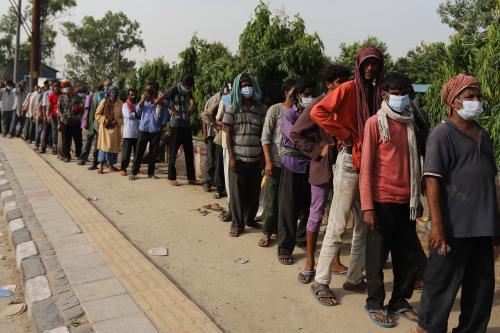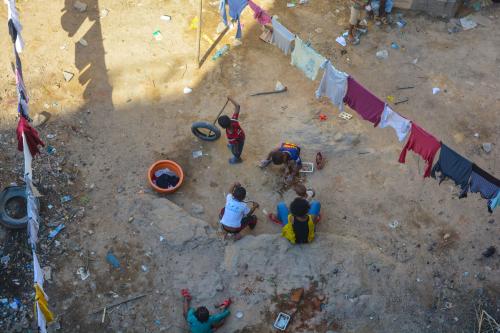We know the economic impacts of COVID-19 have been severe. Advanced and developing countries alike have experienced massive job losses, economic contraction, falling investments and exports, and declining tourism dollars. The impact of COVID-19 on poverty, however, is less clear. We typically get poverty estimates from household survey data, which have been difficult to carry out during the last year. Thus, it may be a year or two before the full impact of the pandemic is known. However, we do know that economic growth is the largest driver of poverty reduction. Conversely, economic recessions drive a rise in poverty, other things being equal. Yet other things were not equal in 2020. Countries responded to the pandemic with large social spending programs to mitigate the worst of the economic shock and keep families afloat. Advanced economies provided trillions of direct and indirect fiscal support, equivalent to 28 percent of their GDP. Emerging and developing economies spent 7 percent and 2 percent of GDP respectively. The World Bank estimates that in March 2020, there were 103 active social protection programs in 45 countries. This number jumped to 1,414 programs in 215 countries by December 2020. These measures likely kept many families from falling back into poverty.
We can be more confident about the long-term impacts of COVID-19. The pandemic, all else being equal, might lead to a temporary rise in poverty in some places before returning to its pre-COVID trajectory as growth rates rebound in 2021 and 2022. In other places, however, growth was low pre-COVID-19 and is predicted to be low for the next decade. In these countries, governments also had less fiscal space for mitigating policy response measures. Using long-term GDP growth projections from the International Monetary Fund (IMF), we estimate where poverty will likely be concentrated in 2030, and what we can do to reverse these trends.
COVID-19 will accentuate the long-term concentration of poverty in countries that are middle-income, fragile and conflict-affected, and located in Africa.
Long-term poverty impacts
Global poverty had been declining before COVID-19. By our calculations, extreme poverty, defined as those living in households spending less than $1.90 per person per day in 2011 PPP terms, had fallen from 1.9 billion people in 1990 to 648 million in 2019, and was on pace to reach 537 million by 2030. COVID-19 interrupted this trend. The absolute number of people living in extreme poverty rose for the first time since 1997, and, absent other measures, we would not expect global poverty headcounts to fall below 2019 levels until 2023. As a result of long-term scarring, we estimate that by 2030, 588 million people could still live in extreme poverty, an additional 50 million people compared with pre-COVID-19 estimates.
These long-term impacts are concentrated in specific countries. According to the latest IMF growth projections, 33 developing countries will still have 2026 per capita income levels (in 2017 PPP terms) below their 2019 levels. Fifteen are in sub-Saharan Africa and nine are small island developing states. In these countries, long-term economic stagnation complicates poverty reduction efforts. High population growth also hinders progress in some countries, with more people being born into poverty than are escaping it. When we look at 2030 poverty estimates, we find that poverty headcounts will be at least 500,0000 higher in 25 countries compared with pre-COVID-19 trends. The countries most impacted are those where poverty was already concentrated before the pandemic—a handful of sub-Saharan African countries and conflict-affected states (see Figure 1). For example, before COVID-19, we predicted poverty in Nigeria would reach 96 million by 2030. We now predict that poverty will reach 112 million by 2030, an increase of 16 million.
COVID-19 will accentuate the long-term concentration of poverty in countries that are middle-income, fragile and conflict-affected, and located in Africa. By 2030, the nine countries with the largest numbers of extreme poor will be in Africa, with Burundi and North Korea tied for tenth place. While poverty was traditionally concentrated in low-income countries, a number of middle-income countries will have large poor populations in 2030, including Nigeria, Tanzania, Angola, and Uganda.
Reversing the trend
These numbers are sobering, but they are not inevitable. These trends could change if countries used the opportunity brought about by COVID-19 to put in place social protection programs to support the most vulnerable. While the proliferation of social protection programs in 2020 was billed as temporary measures, there is some hope that with the infrastructure now in place, these programs can continue to provide assistance for the poor and help them move out of poverty. Big data and machine learning can aid in these efforts, helping governments better identify and target those in need. For example, in response to COVID-19, the government of Togo worked with researchers to use satellite data on population density and mobile phone usage data from Facebook to target cash transfers to the poor. Thus far, the Novissi program has delivered $25 million across 820,000 people, 10 percent of the population. The lessons learned on targeting, verification, enrollment, and payment processing are being absorbed by other countries with limited capacity.
Encouragingly, we estimate that the global poverty gap, the amount of money it would take to hypothetically bring everyone in the world above the extreme poverty line if there were zero transaction costs, is around $100 billion and is set to stay at this level out to 2030 (see Figure 2). To put this in a comparative context, net bilateral Development Assistance Committee (DAC) and multilateral overseas development assistance (ODA) flows for 2020 amounted to $161 billion; an incremental $70 billion in private philanthropy is also being allocated to tackle poverty. While there are many dimensions to poverty other than income poverty, the order of magnitude suggests that mobilizing more aid and government resources should be complemented by a renewed focus on targeting aid flows to the right places.
These efforts will likewise need to be combined with larger structural reform efforts. Poverty is likely to remain high in the countries highlighted above because growth remains stubbornly low. Larger-scale reform efforts are needed in places like Nigeria to get the macroeconomic fundamentals right and to enable long-term growth. While social protection programs are needed to help support struggling families, in the end, greater economic growth is the fastest way to bring people out of poverty.










Commentary
Long-run impacts of COVID-19 on extreme poverty
June 2, 2021